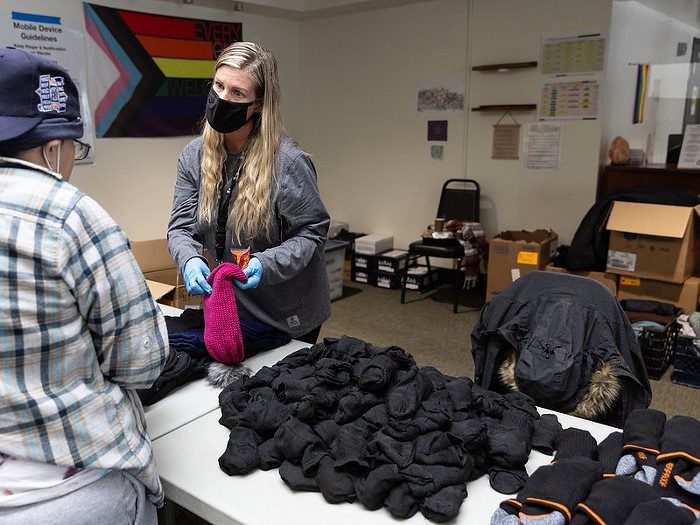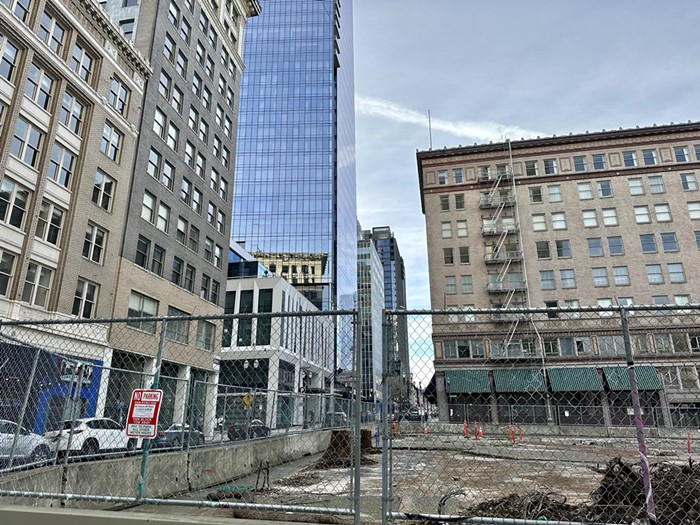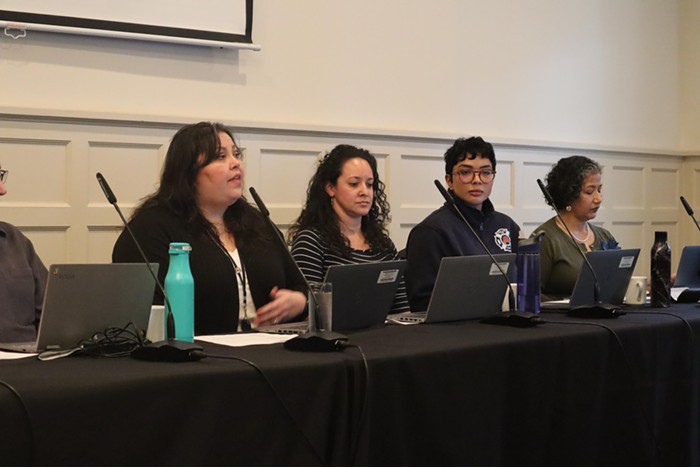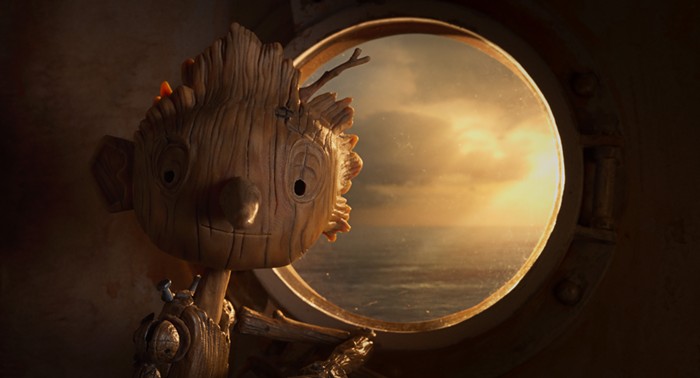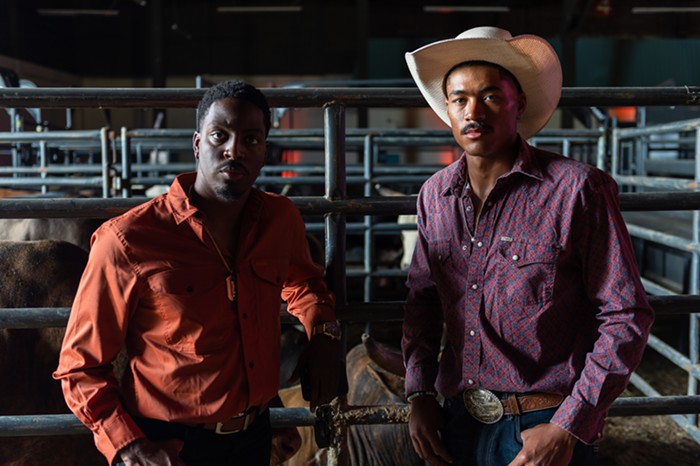As for me, I don't quite fit in. The only vinyl I own is in upholstery. I hate Pabst. And there's no ink anywhere on my body, except the grocery list scribbled on my hand. But I'm meeting someone.
Someone even less hip than me.
A clown.
Staring out the window, I watch as a car--or what looks like a car--comes barreling around the corner. Actually, it's more like a mountain of artwork on wheels: dark skulls, twisted faces, obscure deities, water fountains, and protrusions. Everyone stops and stares. The mood is shattered.
Piloting this mass of art is the man I am meeting. He looks vaguely like Willie Nelson in a clown nose, and is singing at the top of his lungs, beating his dashboard like a drum. As his car rolls down the street, a giant, maniacal face stares backward. Water pours out of its mouth into a pool. It cuts a swath of disbelief through an ordinary day.
I am meeting Extremo the Clown.
THE CLOWN INSIDE MY HEAD
You know who I'm talking about. You've seen him driving around town and wondered who the hell that was. Now I can tell you, his name is Extremo.
Of course, that doesn't really answer the question of who he is. But it's a complicated question. For now, let's just say Extremo wasn't always like this, and even today, when his adrenal gland calms down, Portland's most flamboyant citizen removes his nose and face paint and resumes life as a sign painter named Scot Campbell. Campbell, who lives in the same head as Extremo (and also near Gresham) isn't even sure quite where Extremo came from.
But it must have been a decade ago when the clown first became a glimmer in Campbell's mind. Somewhere, sometime, Campbell bought a clown nose, put in on, and started feeling giddy. There was an odd rattle that welled up in his chest, slowly forming into a huge, raucous laugh.
On that day, whenever it was, Extremo was born.
At the time, Campbell put his nose away and went back to painting signs and putting odd bits of art on his car. But now and then, he was drawn back to the nose. And each time he put it on, Extremo came back a little stronger. More and more often, Campbell found himself in face paint and suspenders with that same giddy grin.
Over the years, Extremo took on a more definite shape, and took up a bigger chunk of Campbell's life. Then in 1996, the clown won a $10,000 prize in the "I exposed 94.7 NRK," contest. On that day, Extremo finally earned his keep. But still, he kept coming back for free, and the place he seemed to like best was in Campbell's car, which was encased in art. In fact, he liked it so much, he claimed it for his own.
"When I get in the car," Campbell says, "he just comes alive. He actually takes over." The Mazda is Extremo's own world. Sometimes, he just drives around, laughing, singing, and playing with his puppets for hours, with no idea what time it is. Time and everything else slips away.
So that's who you see driving the weird car through streets of Portland--Extremo the Clown, mad as a hatter, leaving behind him a froth of emotions: pity, rage, laughter, confusion, and even hope, which is what he wants.
Extremo just wants you to feel something, he says, whether you like it or not.
THE BEST JOKE EVER
I feel a little nervous surrounded by hipsters waiting for Extremo. Right now, he's down the street delivering some artwork to a restaurant. He supports himself by doing commercial art in windows and on walls of businesses around town. Lately, he tells me, he's been doing a lot of fish and fruit.
When Extremo finally pokes his head in the coffee shop, a weight lifts: His nose and face paint are gone, and none of his teeth are blacked out. He is, for the most part, Scot Campbell, the man behind the mask. He sits down with no coffee (he doesn't drink caffeine or alcohol or take any other drugs, believe it or not). And while he seems ramped up a little, agitated, he politely tries to answer my questions. I ask when he knew his life's calling. Campbell knows the answer immediately. It was around 1993.
"I was lying in bed one day." he says, "and I got up and realized I was a clown. That was my purpose. That's what I'm here for."
Actually, this is the second time I've met Extremo, and it went well enough before. He was organized and almost subdued. He gave me his artist statement ("I am not a reclusive person, my art is not meaningful,") and a bio (with info about his work as a top-secret military cartoonist) and his plans for his upcoming art shows in California (Extremoganza and the Santa Ana Caravana).
But today, as Campbell sits in the corner, I can see there's a lot going on upstairs. He talks fast. He fidgets. He can barely contain his laughter. It's like he's always on the verge of something. It seems that Extremo is much closer to the surface of Campbell's mind than before.
"So," I ask, "What's the best time Extremo ever had?"
Campbell is at a loss. "I don't know," he says. "There are too many. It could be today. I mean, easily, today I could have the funnest, most exciting time emotionally that I've ever had in my life. Easily. Like every week, I could have the best time of my life--better than any time as a kid or whatever. That would be so normal. That would be common."
Wow, I say.
He goes on. "You know, it's not like I work all week and suffer so I can hang out on the weekends and drink and be uninhibited. It's the other way around. I'm uninhibited during the day, and at night I go home and become normal and build things and create stuff so I can go out and be crazy the next day."
Campbell goes on about this for a while, exploring the many roads where this leads, which are many. He tells me that I am literally hearing his thoughts as he thinks them, and I believe him. And that is the beauty of Extremo. He's an open book. Like his art, he's just there. Extremo hides nothing.
His is a soul laid bare.
Some interesting facts Extremo shares with me: He's been married for 30 years. He has three kids. His car is a Mazda 626. The longest he's ever laughed nonstop was 15 minutes. (He made a tape of it and almost hurt his back.) His first job was at McDonald's and he liked it. At 18, he was the director of public information for the Church of Scientology in Los Angeles. (Now, he says those people are evil.) He hates Christians. He really hates Christian clowns. (And about 60 percent of the clowns in America are Christians.) He could, he says, cure anyone of coulrophobia (fear of clowns) if he had a million dollars.
"How would you do that?" I ask.
"Easy," he says. "I'd say, 'You stop being afraid of clowns, and I'll give you a million dollars.'"
The talk goes on like this, ebbing and flowing, speeding and slowing, and I can almost watch the man in front of me drift between Scot Campbell and Extremo the Clown. The former is searching, cerebral, friendly, and earnest.
The latter is like a kid in church with the giggles. To Extremo, everything is funny and he constantly seems like he's about to explode. He tells me, at one point, that he could easily out-dance Michael Jackson. This is more than he can handle. He explodes.
Peals of laughter rip through the air at the coffee shop. Around us, hipsters cringe and pull away. They look at us like, "What's he laughing at? What's so damn funny?"
But Extremo doesn't really know what's so funny. Everything. And nothing. Because to Extremo, the world is the best joke ever. And he just can't stop laughing at it.
THE BIG TIME
That's not to say his life is all fun and games. In fact, Extremo works extremely hard at his art, be it commercial or creative. His car represents 2500 hours of labor. His average work day is 12-plus hours, either out on the street painting fish on a pet store window, or in his recording studio doing voice-overs, or hidden in his cramped half-garage working with paints, puppets, and power tools on endless projects in every medium you can think of.
Down the street from the coffee shop, at the Laughing Planet Cafe, Extremo's artwork is splashed across the front window, where the cafe's name is rendered in weirdly life-like characters with bulging eyeballs and toothy smiles. These are typical of his commercial art, and betray that his background is in painting funhouses.
Inside the cafe is more of Extremo's work. This is his fine art. One is a fish smoking a joint. Another is a big smiling hot dog with arms outstretched. Others are fruit with wacky expressions. They are not, as Extremo himself says, meaningful. If this means they're shallow, Extremo doesn't care. He calls this quasi-commercial pieces "visual limericks," that are simply meant to be looked at and reacted to and nothing more.
There is no irony in this work. It's not quaint. It's not retro. It just is. Extremo paints as he talks, and whatever comes into his head spills out in bright colors, round cheeks, cute critters, and dead things. If you want more meaning than that, too bad. Because Extremo doesn't give a shit about meaningful art. He only gives a shit about fun. If he has fun painting something, he paints it.
Surprisingly, there's an emerging market for meaningless art. It's called "low-brow" art, a genre driven more by technique and image than theory, and laced with more humor and narrative than mainstream art. And recently, Extremo's star in the low-brow world has started to rise.
Last winter, he got a call from a friend at Powell's Books who runs the art gallery. She asked if he could have a show ready in five weeks, and he said yes, even though he had no pieces done. Five weeks later, with hot dogs and balloons and Extremo in full costume, Powell's opened what was its most successful show ever with 13 works by Extremo. Every piece sold, but one.
Extremo's next show will be much, much bigger. It will be Extremoganza, a huge affair in Southern California organized by low-brow mogul Greg Escalante, curator of Juxtapoz Magazine and owner of the Capro Nason Fine Art Gallery, one of three venues for Extremoganza. The other two are the Grand Central Art Center and the famous Key Club on the Sunset Strip.
Escalante has become one of Extremo's biggest fans. "What he's doing has never been done before," he says from his home in California. "Just coming out of nowhere and getting a museum venue, a gallery venue, and a night club venue. No recognized artist--no artist--has ever done this before. It's like a grand slam home run the first time up at bat. And he's not even on the team yet."
Extremoganza will feature a choice selection of the wildest art cars, plus 80 works by Extremo the Clown. Or at least, it was 80. But Extremo is painting so fast, the number keeps going up. First to 90, then to 100, and most recently to 120. Where will it all end?
No one knows. But at the moment, Extremo's future looks as bright as the nose on his face. He sees big things for himself. Huge things. He sees his name in lights. He sees himself on Letterman. He sees fame and fortune and the giant funhouse he'll build with his millions.
He sees himself in People magazine: Tom Cruise. Britney Spears.
Extremo the Clown.
THE TAO OF EXTREMO
But in a way, that's almost beside the point. Extremo talks about his upcoming glory like it were a foregone conclusion, an afterthought. He's already moved beyond all that.
Or maybe it's better to say he's already moved back from it: to his art and to his life, and to the alternate reality he has created for himself, in which the mask of Extremo lets him act out his endless creative urges.
A mask is a powerful psychological tool, and humans have used them for thousands of years, to escape, to transcend, and to become something else. These days, most of us use some lesser mask to get through our day and hide things that make us different, so we can pass as the successful businessman, the troubled artist, the cynical writer.
But Extremo's mask isn't used to hide anything. Rather, he uses it to unleash all his ideas and impulses to take the world around him and mold it into something else. For Scot Campbell, the mask of Extremo provides an escape to a world where everything is funny, where all his roiling creative urges are satisfied, and where, most of all, he is happy.
Campbell knows this world of Extremo is his own creation, and that's exactly the point. "Life doesn't mean anything," he tells me in a philosophical moment. "It has no meaning at all. Because all there is, basically, are two realities. There's the physical universe. Everything you see out here, all it is, is atoms. Your body, your brain, your car. Guess what? It's just atoms floating around."
"And then there's another universe," he says, "and that's us." This universe, he says, is our perception. It's the world we create through our eyes, and it's all relative.
"Outside your head there's nothing," Campbell says. "It's like a dream. We're living in a dream, like The Matrix."
This is all very interesting, and from the Extremo's point of view, he has all the philosophical kinks worked out. But he also confides that when he was young, he thinks he might have had mild schizophrenia, and even into adulthood he suffered serious panic attacks. His deepest fear was of two planets colliding.
But since Extremo came into being, Campbell has been more at ease, more relaxed. He's quick to admit that Extremo and art are what keeps him sane. Through the clown, he's found a way to channel his angst into something positive. His mask is like a pressure valve, so that instead of getting washed away by the torrent of biochemicals, he can ride it, surf it, master it.
"IGNORE WILD ANIMALS"
Once I followed Extremo as he drove around town, up and down the one way streets for more than an hour. All around, people watched and stopped and stared. Some laughed and pointed. Some smiled. Some yelled, "You're great!!!" and gave him the thumbs up. At one stoplight, two homeless guys with bedrolls on their backs watched as Extremo poked his monkey puppet out the window at them and sang.
"Keep laughing!" one of them yelled.
The other one just shook his head.
Others, however, give Extremo a different finger. Sometimes, he tells me, they throw rocks at his car and yell, "Freak!" or "Faggot!" Every once in a while this pisses him off, and he decides to fuck with their heads. Once two frat boys were harassing him, so Extremo pulled up real close, and asked if they had wives or mothers.
"I'm going to follow you home!" he told them, with his craziest clown grin. "How would you like that?"
They decided they wouldn't, and drove off.
But that's the exception. Normally, this isn't even an issue. Extremo even has a reminder on dashboard that says, "Ignore wild animals," because, he says, people are nuts and you never know what they're going to do. Someday he might piss off a coulrophobe with a pistol and a bad attitude. So instead, Extremo just laughs it off, as one more funny thing in the world out there, and he cruises down the road, drifting peacefully though his world, blissfully lost in Extremoland.
In the end, this may be Extremo's greatest creation of all, and his finest work of art: A life where he can dress up like a clown, play with puppets, make crazy cars, sculpt paint, cast, carve, and be a kind of star. It is a life of total freedom to do, feel, say, and be whatever he wants.
And most of all, what Extremo wants is what we all want.
"Man," he says over the whine of the espresso machine, "everything just pales in comparison to being in my car, driving over the Fremont Bridge with my puppets, and I'm screaming and singing, and it's just "
He leans back in his chair and trails off and for a minute, before finishing the thought.
" ...that's Nirvana."
